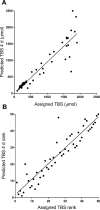A Population-Based (Super-Child) Approach for Predicting Vitamin A Total Body Stores and Retinol Kinetics in Children Is Validated by the Application of Model-Based Compartmental Analysis to Theoretical Data
- PMID: 30488046
- PMCID: PMC6252344
- DOI: 10.1093/cdn/nzy071
A Population-Based (Super-Child) Approach for Predicting Vitamin A Total Body Stores and Retinol Kinetics in Children Is Validated by the Application of Model-Based Compartmental Analysis to Theoretical Data
Abstract
Background: Public health nutritionists need accurate and feasible methods to assess vitamin A status and to evaluate efficacy of interventions, especially in children. The application of population-based designs to tracer kinetic data is an effective approach that reduces sample burden for each child.
Objectives: Objectives of the study were to use theoretical data to validate a population-based (super-child) approach for estimating group mean vitamin A total body stores (TBS) and retinol kinetics in children and to use population-based data to improve individual TBS predictions using retinol isotope dilution (RID).
Methods: We generated plasma retinol kinetic data from 6 h to 56 d for 50 theoretical children with high vitamin A intakes, assigning values within physiologically reasonable ranges for state variables and kinetic parameters ("known values"). Mean data sets for all subjects at extensive (n = 36) and reduced (n = 11) sampling times, plus 5 data sets for reduced numbers (5/time, except all at 4 d) and times, were analyzed using Simulation, Analysis and Modeling software. Results were compared with known values; population RID coefficients were used to calculate TBS for individuals.
Results: For extensive and reduced data sets including all subjects, population TBS predictions were within 1% of the known value. For 5 data sets reflecting numbers and times being used in ongoing super-child studies, predictions were within 1-17% of the known group value. Using RID equation coefficients from population modeling, TBS predictions at 4 d were within 25% of the known value for 66-80% of subjects and reflected the range of assigned values; when ranked, predicted and assigned values were significantly correlated (Rs = 0.93, P < 0.0001). Results indicate that 7 d may be better than 4 d for applying RID in children. For all data sets, predictions for kinetic parameters reflected the range of known values.
Conclusion: The population-based (super-child) approach provides a feasible experimental design for quantifying retinol kinetics, accurately estimating group mean TBS, and predicting TBS for individuals reasonably well.
Keywords: WinSAAM; high vitamin A intake; humans; nutrition assessment; retinol isotope dilution; theoretical children; vitamin A kinetics; vitamin A status.
Figures





Similar articles
-
Use of Model-Based Compartmental Analysis and Theoretical Data to Further Explore Choice of Sampling Time for Assessing Vitamin A Status in Groups and Individual Human Subjects by the Retinol Isotope Dilution Method.J Nutr. 2021 Jul 1;151(7):2068-2074. doi: 10.1093/jn/nxab061. J Nutr. 2021. PMID: 33834213 Free PMC article.
-
The "Super-Child" Approach Is Applied To Estimate Retinol Kinetics and Vitamin A Total Body Stores in Mexican Preschoolers.J Nutr. 2020 Jun 1;150(6):1644-1651. doi: 10.1093/jn/nxaa048. J Nutr. 2020. PMID: 32135013
-
Does the Amount of Stable Isotope Dose Influence Retinol Kinetic Responses and Predictions of Vitamin A Total Body Stores by the Retinol Isotope Dilution Method in Theoretical Children and Adults?J Nutr. 2022 Jan 11;152(1):86-93. doi: 10.1093/jn/nxab337. J Nutr. 2022. PMID: 34549295
-
The Use of Datasets for Theoretical Subjects to Validate Vitamin A-Related Methods and Experimental Designs.J Nutr. 2022 Mar 3;152(3):707-713. doi: 10.1093/jn/nxab441. J Nutr. 2022. PMID: 34967904 Review.
-
Current Capabilities and Limitations of Stable Isotope Techniques and Applied Mathematical Equations in Determining Whole-Body Vitamin A Status.Food Nutr Bull. 2016 Jun;37(2 Suppl):S87-S103. doi: 10.1177/0379572116630642. Epub 2016 Apr 6. Food Nutr Bull. 2016. PMID: 27053491 Review.
Cited by
-
Use of Model-Based Compartmental Analysis and a Super-Child Design to Study Whole-Body Retinol Kinetics and Vitamin A Total Body Stores in Children from 3 Lower-Income Countries.J Nutr. 2020 Feb 1;150(2):411-418. doi: 10.1093/jn/nxz225. J Nutr. 2020. PMID: 31535129 Free PMC article.
-
Development of a Compartmental Model to Investigate the Influence of Inflammation on Predictions of Vitamin A Total Body Stores by Retinol Isotope Dilution in Theoretical Humans.J Nutr. 2021 Mar 11;151(3):731-741. doi: 10.1093/jn/nxaa407. J Nutr. 2021. PMID: 33484140 Free PMC article.
-
Use of Model-Based Compartmental Analysis and Theoretical Data to Further Explore Choice of Sampling Time for Assessing Vitamin A Status in Groups and Individual Human Subjects by the Retinol Isotope Dilution Method.J Nutr. 2021 Jul 1;151(7):2068-2074. doi: 10.1093/jn/nxab061. J Nutr. 2021. PMID: 33834213 Free PMC article.
-
Better Predictions of Vitamin A Total Body Stores by the Retinol Isotope Dilution Method Are Possible with Deeper Understanding of the Mathematics and by Applying Compartmental Modeling.J Nutr. 2020 May 1;150(5):989-993. doi: 10.1093/jn/nxz321. J Nutr. 2020. PMID: 31851323 Free PMC article.
-
Liver retinol estimated by 13C-retinol isotope dilution at 7 versus 14 days in Burkinabe schoolchildren.Exp Biol Med (Maywood). 2019 Nov;244(16):1430-1437. doi: 10.1177/1535370219877132. Epub 2019 Sep 23. Exp Biol Med (Maywood). 2019. PMID: 31547685 Free PMC article.
References
-
- WHO. Guideline: vitamin A supplementation in infants and children 6–59 months of age. Geneva (Switzerland): WHO; 2011. - PubMed
-
- Tanumihardjo SA, Mokhtar N, Haskell MJ, Brown KH. Assessing the safety of vitamin A delivered through large-scale intervention programs: workshop report on setting the research agenda. Food Nutr Bull 2016;37:S63–74. - PubMed
-
- Lietz G, Furr HC, Gannon BM, Green MH, Haskell M, Lopez-Teros V, Novotny JA, Palmer AC, Russell RM, Tanumihardjo SA et al. . Current capabilities and limitations of stable isotope techniques and applied mathematical equations in determining whole-body vitamin A status. Food Nutr Bull 2016;37:S87–103. - PubMed
-
- Green MH. Evaluation of the “Olson Equation,” an isotope dilution method for estimating vitamin A stores. Int J Vitam Nutr Res 2014;84(Suppl 1):9–15. - PubMed
LinkOut - more resources
Full Text Sources

